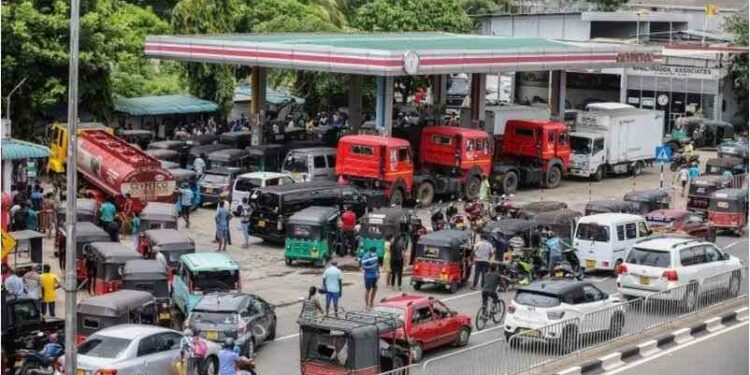COLOMBO — Serpentine lines of motorists awaiting fuel rations have become a common sight in Sri Lanka’s commercial capital of Colombo, as the country grapples with an unprecedented economic crisis. Some queues stretch for miles, with auto-rickshaw drivers and car owners baking in the sun to get their hands on a few precious liters. Several people are reported to have died while waiting.
But not everyone waits. A black market for gas has sprung up. The fuel trade is a microcosm of the different ways people in the country of 22 million are experiencing the economic woes, depending on their level of wealth, as the authorities scramble to stop illicit sales and find long-term solutions.
Dylan Lloyd, 19, is one of the many who dutifully wait in line. He suffers from a respiratory condition that makes taking public transport daunting, especially now.
“I need to stand in the line from Tuesday to get my quota of 13 liters on Thursday,” he said, standing outside a Ceylon Petroleum Corporation (Ceypetco) gas station when he should have been in school. “It doesn’t even last us half a week. A few days later, I am back in the queue. I even tried to take the bus. But there are fewer buses now and they get very crowded. If I am sitting in the middle, it gets difficult for me to breathe.”
Lloyd and others like him are in this position due a combination of factors — COVID-19’s impact on tourism, economic mismanagement, and the Ukraine war’s pressure on prices. As Sri Lanka’s foreign reserves dwindled, the country defaulted on foreign debt for the first time in May, making it even harder to borrow money and import essentials like fuel and medicine.
The country has resorted to fuel rationing. On July 21, Ceypetco began dispensing fuel based on the last digit of a driver’s license plate. Those ending with 0, 1 or 2, for can buy fuel on Tuesday and Saturday, and so on. Limits vary, depending on vehicle type.
Sri Lanka’s annual inflation rate has hit 60%, according to the central bank. Fuel is so scarce that stations are charging 450 Sri Lankan rupees ($1.24) a liter for gasoline, up more than 500% from around 70 rupees before the crisis.
Some are willing to pay much more — a fact not lost on some Sri Lankans amid the daily fight for survival.
“Wealthy people don’t like to wait in queues. So when I get my quota of 5 liters, I sell it to the highest bidder. I charge 2,500 rupees per liter, which is far more than what I’ll earn from driving people around,” said Ibrahim, an auto-rickshaw driver who asked to use a pseudonym.
He explained that black marketeers hide fuel in cans and deliver it to buyers. Still, Ibrahim said his earnings have remained far below his living expenses. And it is only getting harder to scrape by as the authorities try to stamp out the black market.
On Aug. 1, the government introduced a QR-code-based National Fuel Pass that requires all motorists to register their vehicles. Kanchana Wijesekera, the energy minister, posted on Twitter that all gas stations must exclusively dispense fuel to vehicles through this system.
A media release also encouraged citizens to send video or photographic evidence of illegal fuel stockpiling or sales to designated hotlines.
Ibrahim said he sold his smartphone for 9,000 rupees, so he “can’t even use the QR system.”
“Our life is very tough,” he said. “We are six people in my family, and some days my kids eat only one meal. Everything is so costly these days that even selling fuel illegally is not enough to meet our needs. I will soon have to look for another job.”
Relief is nowhere on the horizon. The Energy Ministry said in late July that fuel imports had to be restricted for 12 months due to the foreign currency crunch.
Some question that move, arguing it runs counter to the government’s earlier decision to open up the energy market to overcome the fuel shortage. On June 29, Wijesekera had announced on Twitter that the cabinet had decided to allow companies from any oil-producing countries to offer fuel, in effect ending the duopoly that allowed Ceypetco to control 80% of the market while Lanka IOC, a unit of Indian Oil, handled the rest.
The companies “will be selected on the ability to import fuel and operate without forex requirements” from the central bank for the first few months of operations, the minister wrote at the time.
“The strategy to restrict imports is wrong,” said Shashi Dhanatunge, who was a Ceypetco board member from July 2017 to October 2018. With the economy already in shambles, he said, “fuel rationing will not achieve any results rather than postponing our recovery time.”
Instead, he argued the cabinet needed to act on the decision to liberalize the market, by reducing paperwork and simplifying the procurement process. But it may be a big ask: Dhanatunge said the government was insisting that interested parties should import cargo for up to 12 months without obtaining dollars locally.
Meanwhile, it remains uncertain how successful the QR system will be at curbing the black market, and desperate Sri Lankans are likely to continue seeking ways to augment their incomes.
“I know many people who buy fuel from the black market,” said S. Devagurunathan, a 56-year-old hardware story owner in Colombo. “it is illegal and one should not do it. But not everyone can stand in a queue. For instance, I should be at my shop, but I am standing here in a line.”
Devagurunathan said the economic woes have forced citizens to take “extreme” measures. “How else will we feed our families?”
Source:asia.nikkei.com


